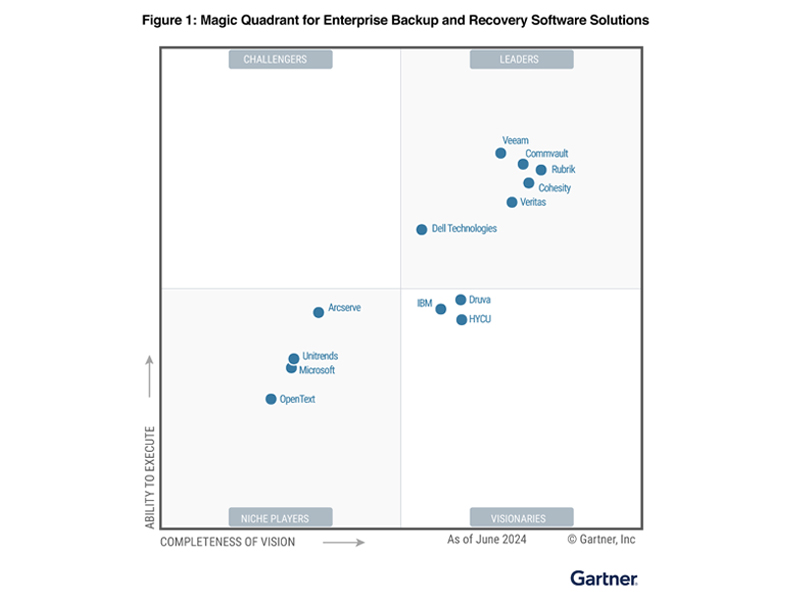The Gartner Magic Quadrant report on backup and recovery is an annual review of available data protection solutions that meet specific criteria regarding their functionality and feature sets. The report provides potential customers with an objective evaluation of the backup and recovery solutions that can address their business needs. Gartner’s reputation for solid technical research ensures that companies receive reliable information with which to make purchasing and implementation decisions.
We will discuss how vendors are included in the report and what it means to be located in one of the quadrants. Then, we’ll look at VAST’s strategic partners, who are included in the Leaders and Visionaries categories of the report.
Gartner’s Strategic Planning Assumptions
Gartner’s research is informed by assumptions to be considered when selecting a backup and recovery solution. These assumptions address the projected state of enterprise backup and recovery in 2028. They include:
- 75% of enterprises will use a standard solution for on-premises and cloud infrastructure, up from 20% in 2024;
- 75% will prioritize backing up SaaS applications compared to 15% in 2024;
- 75% of large enterprises will adopt backup-as-a-service (BaaS) solutions to supplement existing tools.
Enterprise Backup and Recovery Capabilities
Gartner places vendors in specific quadrants of the report based on their ability to provide three categories of capabilities. Inclusion in the report requires a backup and recovery solution to include all must-have capabilities.
Must-have capabilities
- Backups must be capable of handling all on-premises and hybrid multi-cloud environments. This includes backing up infrastructure as a service (IaaS), platform as a service (PaaS), database as a service (DBaaS), and SaaS cloud offerings.
- Solutions must support recovery from any failure or data loss scenario. This support requires management policies and the ability to handle recovery point objectives (RPOs) and recovery time objectives (RTOs) to address regulatory compliance.
- The solution must provide immutable storage or integrate with an immutable storage platform.
Standard capabilities
Standard capabilities expected of backup and recovery software include:
- Protection of critical data in SaaS or PaaS applications;
- A centralized management console;
- Enhanced security functionality, including multi-factor authentication;
- Orchestration of cyber recovery testing.
Optional capabilities
Additional optional capabilities and features may differentiate a solution from its competitors. These capabilities include:
- Protection of additional workloads such as edge computing environments;
- Vendor-hosted control planes and backup-as-a-service (BaaS) offerings;
- Generative AI features to facilitate administration;
- Support for expanded data backup use cases such as compliance and e-discovery.
Criteria for Inclusion in the Report
The criteria for inclusion in the Magic Quadrant report start with the requirement to include all must-have capabilities in their solution. The following additional inclusion criteria apply.
- Before April 1st, 2024, vendors must have at least one qualifying backup and recovery solution commercially available for three calendar years.
- Vendors must meet revenue standards generated specifically by their backup and recovery solution.
- A vendor must have an installed base of at least 1,000 customers. At least 250 customers must deploy the solution on at least 100 physical or 300 virtual servers in a single deployment site.
- The product must be installed in at least three major North America, EMEA, Asia/Pacific, and South America geographies.
- The backup and recovery solution must be sold and marketed primarily to companies with at least 500 employees.
- Products may be sold as software, appliances, or vendor-hosted BaaS solutions.
Quadrant Descriptions
Each Gartner Magic Quadrant contains vendors that meet one of the following descriptions.
- Leaders—These vendors demonstrate the highest combined measures of Ability to Execute and Completeness of Vision. They offer comprehensive and scalable product portfolios to support the backup and recovery requirements of hybrid, multi-cloud, and SaaS IT environments. They have a proven track record and a high success rate in winning new business.
- Challengers—Vendors designated as challengers can execute today but have yet to produce or market their vision entirely. They have financial and market resources but may need to focus on better understanding market trends for continued success.
- Visionaries—These vendors are forward-thinking and have capabilities ahead of the market. However, their lack of execution limits their inclusion as leaders or challengers. They offer innovative solutions but need to improve sales and marketing.
- Niche players—Vendors considered niche payers may focus on a particular geographic region, vertical market, or use case. These companies are worth watching and may offer solutions that fit specific business needs.
VAST’s Partners in the Magic Quadrants
Several of VAST’s strategic partners are included in the reports as leaders or visionaries. VAST’s backup and recovery experts team can help your organization select and implement a solution that aligns with your business objectives.
Leaders
- Veeam—Veeam’s position as a leader in the Magic Quadrant is due to multiple factors. In the last 12 months, they have released product updates that include new features such as in-line malware detection, an AI assistant, an improved reporting dashboard, and content analysis. Veeam is responsive to market trends, as seen by its introduction of a BaaS solution for Azure and Microsoft 365.
- Cohesity/Veritas – Cohesity acquired Veritas NetBackup in the most significant merger in the backup market in over a decade. The combined portfolio of these two Gartner leaders provides customers with an extensive selection of backup and recovery solutions. The company has steadily delivered innovative data protection capabilities for on-premises environments, cloud infrastructures, and SaaS applications. The Veritas Alta platform and NetBackup can run in Kubernetes clusters on AWS, Azure, and the Google Cloud Platform (GCP).
Visionaries
- Druva—Druva attained visionary status due to its innovative, cloud-native BaaS offering, which provides an easy-to-use and scalable backup solution for on-premises and cloud environments. It’s a great backup and recovery solution. The company recently introduced an AI copilot named Dru and curated recovery for SharePoint and Microsoft OneDrive data.
Contact us and see how VAST has your back regarding backup and recovery solutions that align with your business requirements.



